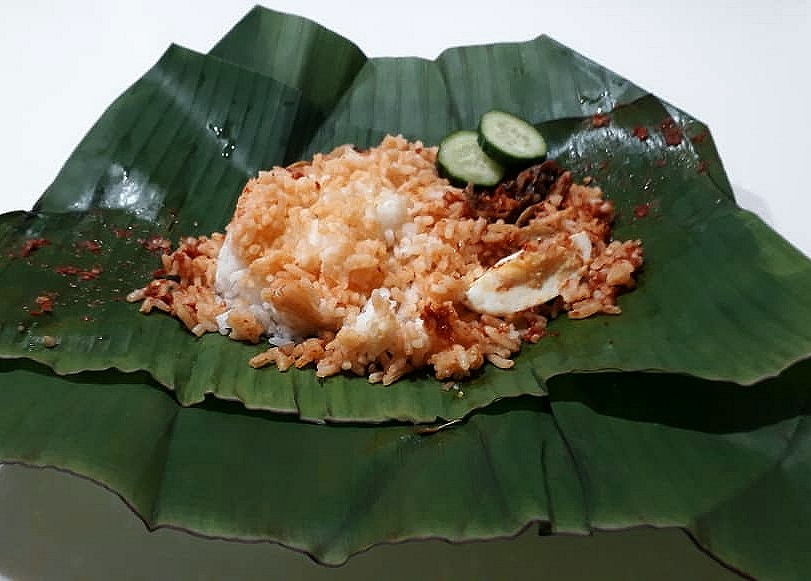
Sambal is used everywhere in Malaysian cuisine. It comes in so many varieties, and is used in many ways throughout the country’s dishes. From a sauce to stir-fry vegetables with, to a base for soup, to a condiment on the side of a dish, sambal is used everywhere. It is generally both sweet and spicy, great for opening up the airways and giving the taste buds a kick in the, er, bud. And of course, it is an irreplaceable part of Malaysia’s national dish – Nasi Lemak!
The staple of fragrant rice, sambal, egg and other garnishes is available everywhere in Malaysia. From the simple 1 ringgit pyramids wrapped in banana leaves, to a lavish lobster version from upmarket hawkers and restaurants, you’ll always have a dollop of sweet, spicy goodness there to make everything taste even better. I personally love trying out the cheap pyramids of Nasi Lemak often sold by aunties by the side of the road or at kopitiams, and find they very often include a version of sambal that is cooked with anchovies – Sambal Ikan Bilis! No, these aren’t the anchovies that westerners are used to; the delicate, pungent, oily fillets that turn to mush as soon as you start cooking with them. These come dried and are deep fried before being added to the sambal, making them almost chewy after absorbing some of the moisture. They’re also needed as a garnish to nasi lemak, along with roasted peanuts.
This recipe can easily be adapted to make a basic sambal without the ikan bilis, but why on earth would you want to remove them?
Ang Moh’s Sambal Ikan Bilis Recipe
Serves 4, or 2 Malaysians
Ingredients
6 shallots (around 120g) – peeled, 4 of them quartered to be blended, the other 2 sliced into rings
2 cloves of garlic
10 dried chillies, or 10 fresh red chillies, or a mixture of the two. If you use all fresh chillies, you may wish to de-seed some of them, depending on your preference to heat
6g belachan shrimp paste
60g dried ikan bilis – the western tinned anchovies will do if ABSOLUTELY necessary
4 tbsp tamarind paste
1 tsp tomato puree
2 tbsp sugar
additional salt and sugar to taste
Directions
Prepare your initial paste by blending the 4 shallots, garlic cloves, chillies and belachan together, adding a small amount of water if needed to help the blender. Set this aside, and next it’s time to wash your dried ikan bilis. These little fishies are usually extremely salty, so you’ll want to immerse them in water and stir them around for a bit with your fingers to try and get most of the salt off. We don’t want the ikan bilis getting too waterlogged though, so only wash them for a minute or so before removing and spreading out on some kitchen paper to dry.
While the ikan bilis is drying off, put some oil in your wok/saucepan and heat it up to a medium-high heat. Add your paste, and stir fry for a few minutes until it has started to brown and is fragrant, then add in the shallot rings, and stir occasionally for a few minutes again until the rings have softened. We can now add the ikan bilis, tamarind paste, water, tomato puree and sugar to the mixture and allow it all to heat through. Reduce the heat and let the sambal simmer for 5 minutes or so before checking the taste. Depending on how salty the ikan bilis were, you may need to add a bit of salt or sugar to balance the flavours.
When the sambal is nicely fragrant and has a good sheen on it, it should be ready. Best served as a side to Nasi Lemak, but can just as easily be enjoyed with rice and veggies.
Main image courtesy of Dr Ooi of Tanjung Bungah, Penang

3 comments
Zijian Chong
November 20, 2019 at 4:07 pm
Hello angmohcooksmalaysian! I like all your recipes
Zijian Chong
November 20, 2019 at 4:10 pm
I was going to ask a question in the previous comment, but it got posted by accident!
I want to know how you work out your ratio for normal people to Malaysians. In your assam laksa and koey teow th’ng recipes, it is for 6 people or 4 Malaysians, but for this sambal, it is 4 people or 2 Malaysians. So, is it 3:2 or 2:1? Your feedback will be much appreciated!
angmoh
November 21, 2019 at 9:22 am
Gut feeling really, and many years of studying how much my wife can eat!